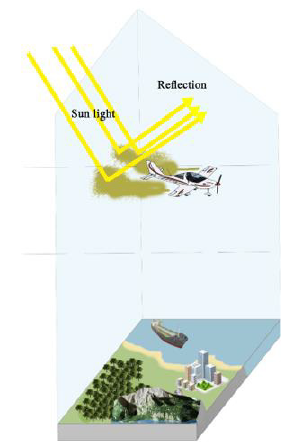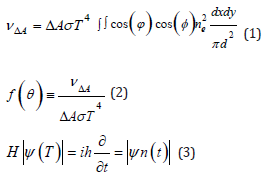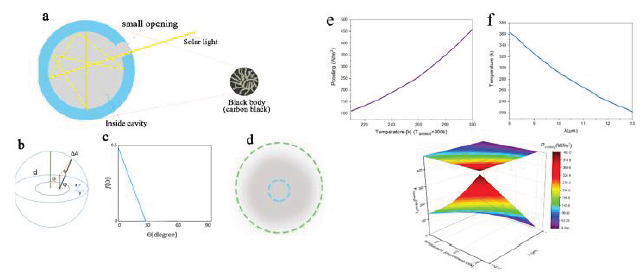- Submissions

Full Text
Aspects in Mining & Mineral Science
High Performance of Particles with a Black Body to Decline Temperature
Chamkouri H1,2*, Chamkouri M2 and Saeidavi FH2
1Faculty of Chemical Engineering and Petroleum, University of Tabriz, Iran
2Danesh Paper Company, Iran
*Corresponding author: Hossein Chamkouri, Faculty of Chemical Engineering and Petroleum, University of Tabriz, Tabriz, Iran
Submission: October 29, 2021;Published: December 02, 2021

ISSN 2578-0255Volume8 Issue1
Abstract
If appropriately designed and calculated, terrestrial particles can inactively cool the planet by the emission of heat and solar light to space. In this research, we present a carbon black as a black body talented in cooling the earth’s surface in diurnal situations. The particles perform as a mirror and reflector for solar light, whereas consecutively emitting powerfully the light and heat outside the atmosphere, attaining a cooling power in an extra of 259W/m2 at 300k or ambient temperature. This cooling continues in the occurrence of heat exchange in atmospheric environments.
Keywords: Porous materials; Powder technology
Introduction
The atmosphere of our planet has transparency for sun radiation that corresponds to thermal radiation at common ambient temperatures while it is thick. By manipulating this part, it certainly can cool a layer on the surface of the Earth by reflecting its heat and light away into space as a cold and dark environment. This mechanism of cooling is an attractive strategy to decline the temperature of the environment in the lithosphere and hydrosphere without the essential energy or performance. Though nocturnal cooling and freezing have been widely investigated [1,2] the time need for cooling happens throughout the hours of daylight. Therefore, it is an unlimited eminence to discover the prospect of hours of daylight cooling. To accomplish daytime freezing and cooling one requirement to propose a configuration that is consecutively a structure mirror for solar radiation, light, and operationally good thermal emitter with high stability in the atmospheric condition. A preceding study in diurnal cooling has required to accomplish this by covering a black emitter with a protection foil [3]. The foil, prepared by pigments and polymers, [4] transfers heat energy whereas reflecting solar light. Nevertheless, no definite cooling was confirmed because there was no efficient report to reflect solar light. In current years, substantial development has been made in the reduction of temperature and reflection of light from nanostructure [5] but the material which is used in this research considerably harmful. In numerous methods, the stratosphere as an important layer is a perfect place to create the atmosphere extra reflective. Particles released there should spread all over the globe and stop in the air for 24 months or further. If located tactically and frequently in the left and right hemispheres, they possibly will create a uniform situation that would protect and shield the whole sphere (Figure 1). In this research work, the particles and geometry of carbon black of burned wood were studied and evaluated, which calculated and investigated the amount of radiation and temperature decrease due to the presence of particles. This natural material is a very suitable option due to its low price and its availability. It also easily commercializes and can be used extensively in a short period for global modification. Medically, these particles have less effect on the human body than particles used in other articles. Carbon black was selected according to the well-known Stefan–Boltzman law that states, microscopic material cannot emit more heat and radiation than a material with a black body. In the research group, we were a group of three people who did experimental work and data analysis.
Figure 1: Schematics shows the distribution of particles in the stratosphere.

Experimental
Material and process
Coals are made of carbon and the amount of carbon remaining in this heating process can affect the quality of the coal. In a small system, indirect heat equivalent to 120 to 180 °C was applied to the wood for 7 to 8h to reach the proper amount of carbon and finally to prevent burning and ash. Carbon Coal has to completely seal or suffocate them in the tank to cool them, and it turned out to be a great product with a high purity of about 98% and then powdered to particulate matter. Besides, wood models also have a great impact on the quality of coal and depending on the hardness or softness of the wood, the quality of the coals and how they are heated also vary. Therefore, eucalyptus wood was used in this research. Figure 2 shows the production process of high-purity carbon coal.
Figure 2: Shows chemical (a), physical (b) and thermal stability of particles.

Characterization
X-Ray Diffraction (XRD) and Fourier Transform Infrared (FTIR) spectroscopy were used to confirm the chemical and physical structure of carbon black. The Thermogravimetric Analysis (TGA) test was also used to measure the thermal resistance of this material.
Total internal reflection condition
The special geometry of particles affects absorption and develops the situation that permits radiation from the main zone to emission from the particles without reflection of the whole interior. The radius r is a parameter in the releasing zone. Radius R is used for particles. In the physical appearance of the particle, the ray occurrence angle is f. By the sine instruction, we need sin(ᵠ)=r sin(Ө)/R. As a poorest-situation scenario, we consider supreme radiation from the main source to the particles, that is, the extreme assessment for Ө is 90. To stop the reflection of the whole inside, we need that sin(ᵠ)≤1/ne. Through these attentions, we hence have R≥rne.
All equation listed below:

Result and Discussion
Characterization of carbon block
Figure 2a confirmed the chemical structure of the carbon block obtained from wood. The stretching vibrations of the O‒H peak at 3,440cm-1 that reveals the existence of alcohol on the surface of the structure. The peaks at 2,851cm-1 and 2,919cm-1 related to the asymmetric and symmetric C‒H aliphatic acids vibration separately owing to the stretching. As can be seen, the peak at 1,700cm-1 is ascribed to the stretching vibration groups of carboxyl (–COOCH3, –COOH). The peak detected at 1,590cm-1 is owing to stretching of C=C that certainly referred to the C‒C as an aromatic bond. The peaks observed at 1,430cm-1 are owing to the CH3 as symmetric bending. The peaks detected at 1,262cm-1 display the C‒N stretching existence in the aromatic tertiary amines. The detected peaks display C‒H through-plane bending in the aromatic ring detected at 750 and 880cm-1. XRD graphs of carbon black are represented in Figure 2b. The attained carbon black shows broad peaks at 43° and 25.5° as detected formerly in the example of amorphous carbon and dust [6]. These detected peaks relate to inter-planar spaces of 2.1 and 3.5 Å correspondingly. The minus intense observed peak at 43° is accredited to the existence of a diamond plane in the patterns [7]. Structures in this aim must have high-temperature resistibility, as beginning temperatures of weight loss are upper than approximately 400 °C, as displayed in the thermal examination (Figure 2c). Therefore, the structure would be trustable in a hightemperature environment.
Solar light and thermal performance
Carbon black was considered a black body. A blackbody or particles are defined as objects that absorb completely the radiation of electromagnetic waves on the structure. It must have Af=1 for all wavelengths for the reason that emission and absorption are demonstrated that a blackbody as a flawless absorber is similarly a supreme radiator. In practice, a heated cavity as a small opening in all parts performs identically to a blackbody because works entirely as opening traps (Figure 3a). The solar light emitted through the cavity is in the thermal balance by the barriers, for the reason that it has been re-emitted and absorbed numerous times. To experimentally calculate the entire power per unit area released at all waves through a heated solid was related to the quarter power of its total temperature. The thermal energy distribution on the surface of the black body can be considered through a schematic revealed in Figure 3b. For a small zone ΔA on the structure surface, the thermal energy power it obtains from the Eq. (1 and 2). The descriptions of the geometric factors in Eq. (1) are supported in (Figure 3c) and ᵠi is the top angle as well-defined. All energy that zone ΔA obtains can emission the structure. As a quantity of dimension, we describe a stabilized distribution of power to define the distribution of power on the exterior of the black body. Due to the rotating structure of the particle, f hinge merely on the angle y. As one precise mathematical instance, we select the radius of structure R=5r to gratify the disorder R≥ner. f(y) is mathematically assessed by Equation (2) and is revealed in (Figure 3c) for the only unfilled cavity (ni=1) (Figure 3d). For this case, f(y) certainly not surpasses harmony. This is predictable by considering the law of Stefan–Boltzman: as the black body is in nonstop interaction with the outside, the radiation from each external part cannot surpass that of a surface of a blackbody through the identical zone. 8-13μm wavelength was considered as the intended wavelength for the Earth’s surface with temperature changes. The diffusion and the amount of heat reduction were then evaluated. Throughout the daytime, the condition of zero emissivity exterior the atmosphere is reasonably difficult and decreasing the solar light absorption is vital with the aim of achieving cooling. To reveal this achievement, we design P(T) in (Figure 3e), for a perfect radiative cooler through the perceptive emissivity defined. The cooler performance growth as the absorb ton of energy increased in the occurrence of the astral light, as revealed in Figure 3a. The perfect diurnal radiative cooler can influence an actual range of temperature, but through absorption of solar light per unit per meter, the black body normally reduced temperature effectively around 18.2 %. Figures 3f & 3g displays the emission of the particle and heat in divers’ temperatures because wavelengths vary. The emission peaks at 8-13μm wavelength, as predictable for a black emitter (black body) at a temperature of 300K. The perfect black structure of the same dimension as the carbon black is strategized as considered material in this study. As predictable, emissivity for carbon black in this study is 18.2% in the common trend.
Figure 3: Absorption of solar light in carbon black (a), the calculation (b), Scattering of the energy power on the layer of the particle (c), the structure of the unfilled particle (d), cooling power for the determined structure (e), alteration of temperature with wavelength (f), and 3D graph of cooling power with temperature and wavelength.

Conclusion
The observation of thermal abstraction here unseals potentials for several presentations. For instance, there is a robust determination looking to reduce the energetic emitting area of a current source, through a smaller region. In this research, we have offered another method to emit thermal light from particles, cooling power. In contradiction of preceding applications, the emission of thermal light to cool planet does not need the operation of high temperature. We accordingly expect that cooling power will inspire persistent research and attention in solar light and materials.
Acknowledgment
The authors appreciated the Danesh Paper Company (DPC) for technical support.
References
- Gentle AR, Smith GB (2010) Radiative heat pumping from the earth using surface phonon resonant nanoparticles. Nano Lett 10(2): 373-379.
- Suryawanshi CN, Lin CT (2009) Radiative cooling: lattice quantization and surface emissivity in thin coatings. ACS Applied Materials & Interfaces 1(6): 1334-1338.
- Nilsson TM, Niklasson GA, Granqvist CG (1992) A solar reflecting material for radiative cooling applications: ZnS pigmented polyethylene. Solar Energy Materials and Solar cells 28(2): 175-193.
- Silvestrini V, Peraldo M, Monza E (1982) Covering element screening off the solar radiation for the applications in the refrigeration by radiation.
- Greffet JJ (2011) Controlled incandescence. Nature 478(7368): 191-192.
- Sharma A, Kyotani T, Tomita A (2000) Comparison of structural parameters of PF carbon from XRD and HRTEM techniques. Carbon 38(14): 1977-1984.
- Chen P, Huang F, Yun S (2003) Characterization of the condensed carbon in detonation soot. Carbon 41(11): 2093-2099.
© 2021 Chamkouri H. This is an open access article distributed under the terms of the Creative Commons Attribution License , which permits unrestricted use, distribution, and build upon your work non-commercially.
 a Creative Commons Attribution 4.0 International License. Based on a work at www.crimsonpublishers.com.
Best viewed in
a Creative Commons Attribution 4.0 International License. Based on a work at www.crimsonpublishers.com.
Best viewed in 







.jpg)






























 Editorial Board Registrations
Editorial Board Registrations Submit your Article
Submit your Article Refer a Friend
Refer a Friend Advertise With Us
Advertise With Us
.jpg)






.jpg)














.bmp)
.jpg)
.png)
.jpg)










.jpg)






.png)

.png)



.png)






